Camden Loop
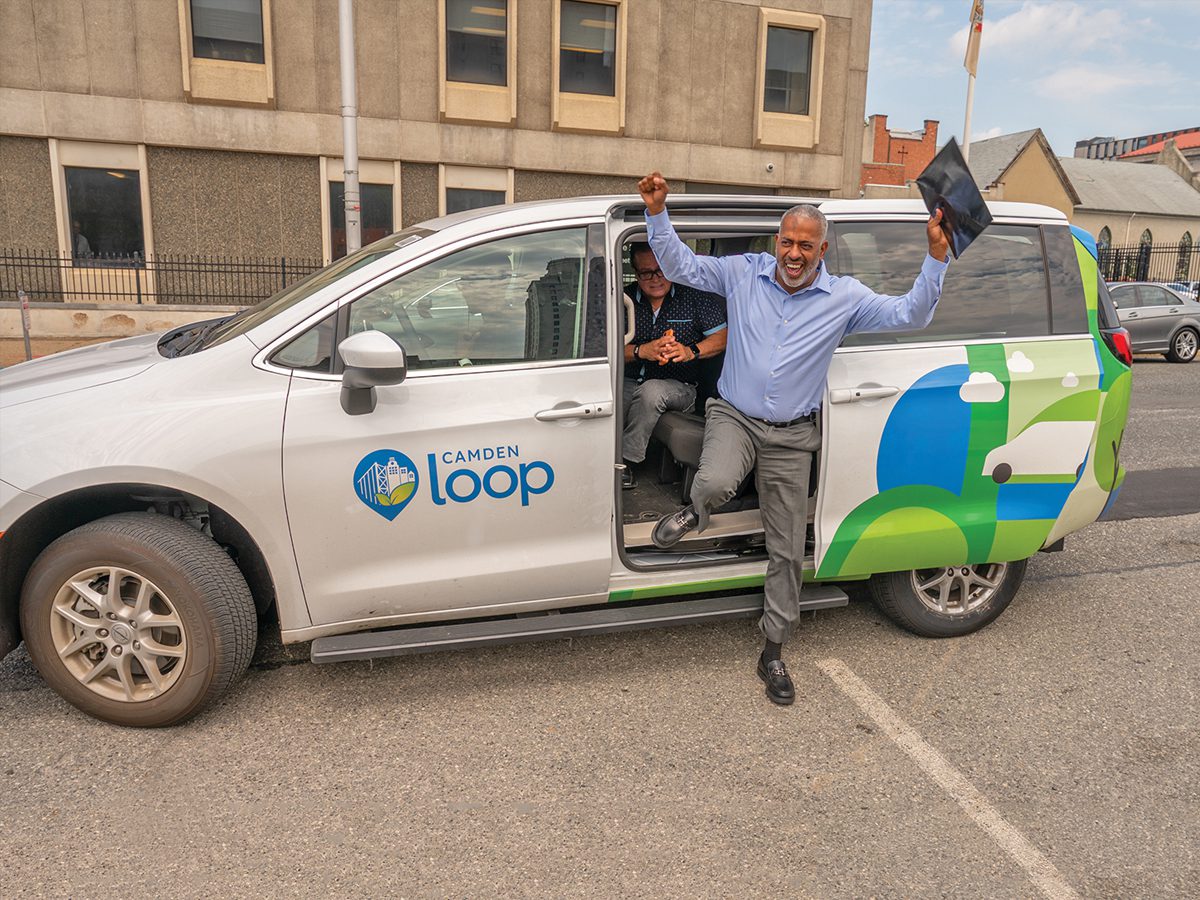
A community-driven rideshare program revolutionizes urban transit
Loticia Ferguson starts her day early, steering her car through familiar city streets to pick up residents on their way to work. Some passengers are new, but many are the same faces on the same route at the same time.
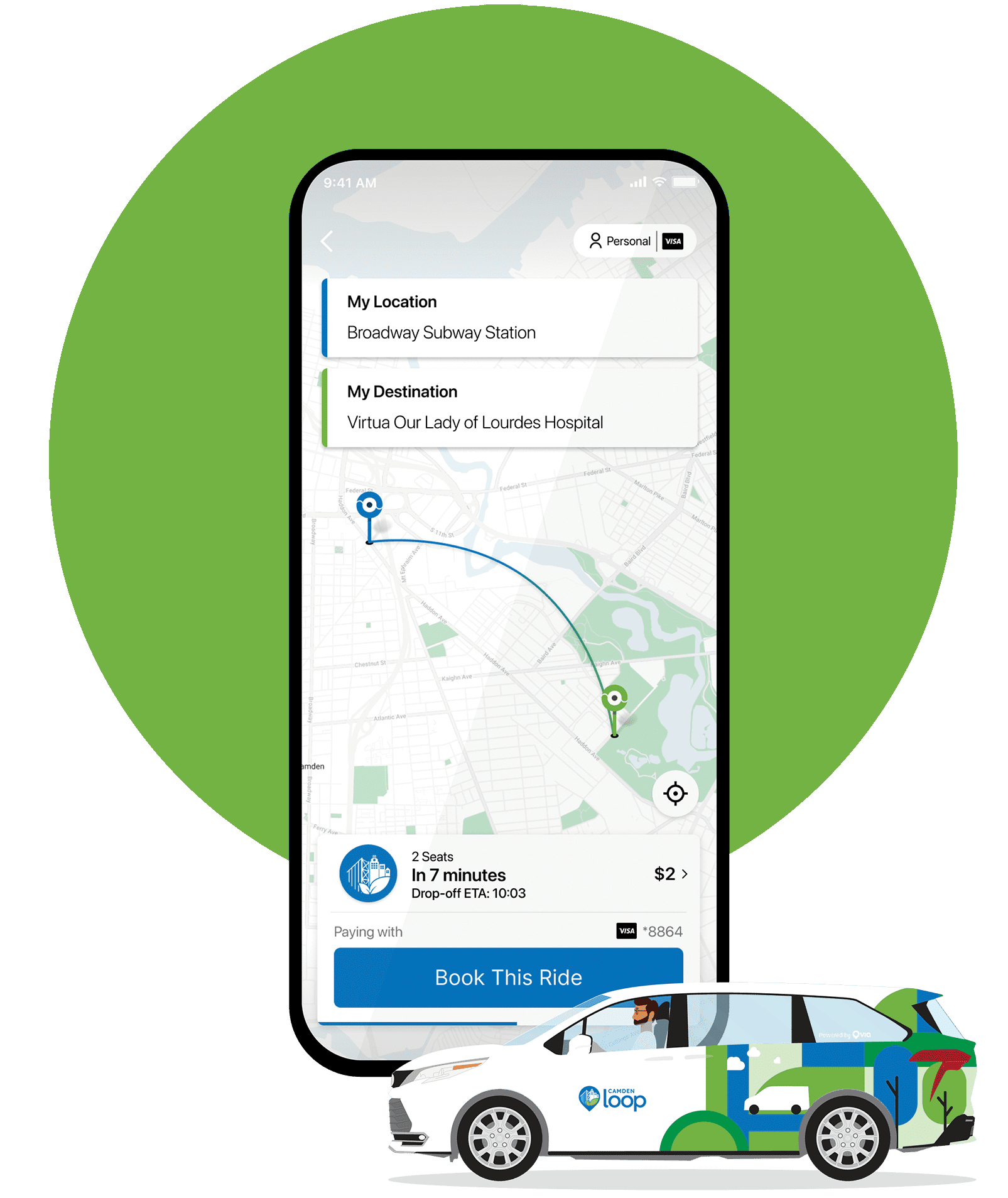 Ferguson is a driver for the Camden Loop, an on-demand rideshare service run by Camden Community Partnership. The process is very similar to Uber or Lyft, where passengers order a car through an app on the phone, but there are a few differences. The most important: each ride costs $2.
Ferguson is a driver for the Camden Loop, an on-demand rideshare service run by Camden Community Partnership. The process is very similar to Uber or Lyft, where passengers order a car through an app on the phone, but there are a few differences. The most important: each ride costs $2.
The Camden Loop program began in June 2023 as a new, affordable transportation option to connect residents to employment, healthcare, food access and other social determinants or needs, including culture and entertainment.
“The remarkable success of the Camden Loop showcases how accessible and reliable transportation services can significantly enhance residents’ quality of life and drive economic growth,” says NJ Assembly Majority Leader Louis D. Greenwald.
The program primarily assists Camden residents who lack access to personal vehicles. According to a 2024 rider survey,
9 out of 10 respondents do not own a car and 85% report saving money by using the service.
“In Camden, transportation is one of the biggest barriers to access employment opportunities,” says Dana Redd, President and CEO of Camden Community Partnership.“The Camden Loop creates an affordable and efficient transportation option to get residents to other modes of public transportation that connect them to parts of the city.”
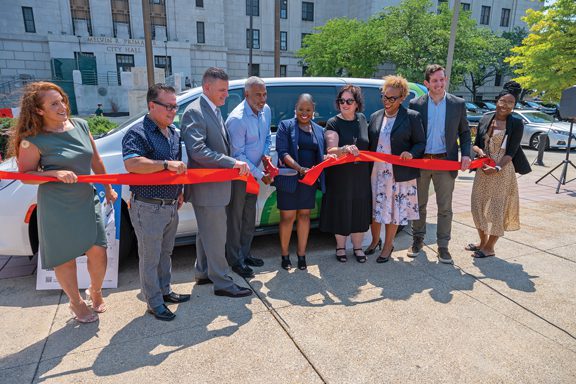
The process is simple – users download the Camden Loop app and request a car to take them where they need to go Monday to Friday, between 6 am and 8 pm.
The Camden Loop uses intelligent algorithms from TransitTech provider Via. Once a rider books a ride, the algorithms match other riders headed in the same direction into the same vehicle, similar to an Uber Pool.
This system ensures rapid, cost-effective transportation, with each ride costing just $2, and an additional dollar for each extra rider in the same booking. Users can also opt for monthly subscription plans, called a LoopPass. Riders can choose a 7-day subscription for $7 (ride up to 4 times per day for 7 days) or a 30-day unlimited subscription for $26. Moreover, the service is inclusive, offering wheelchair-accessible vehicles.
The ride-share service isn’t meant to be a replacement for public transportation – rather, a way to bridge the gap between areas of the city that aren’t easily accessed by established transportation. To date, the app has more than 10,000 active users, and Loop drivers have completed more than 30,000 rides.
“The overwhelming response to this program demonstrates the need that existed here in the city for far too long in terms of residents not being able to access the places they need to live full, healthy, happy lives – whether that means getting to a doctor’s appointment or attending a concert held down on the waterfront,” says Redd. “We’re even starting to get requests from school districts and higher education programs to establish ways to get students back and forth from class safely and easily.”
The most popular ride locations so far include sites for education, healthcare facilities, transit hubs and shopping centers.
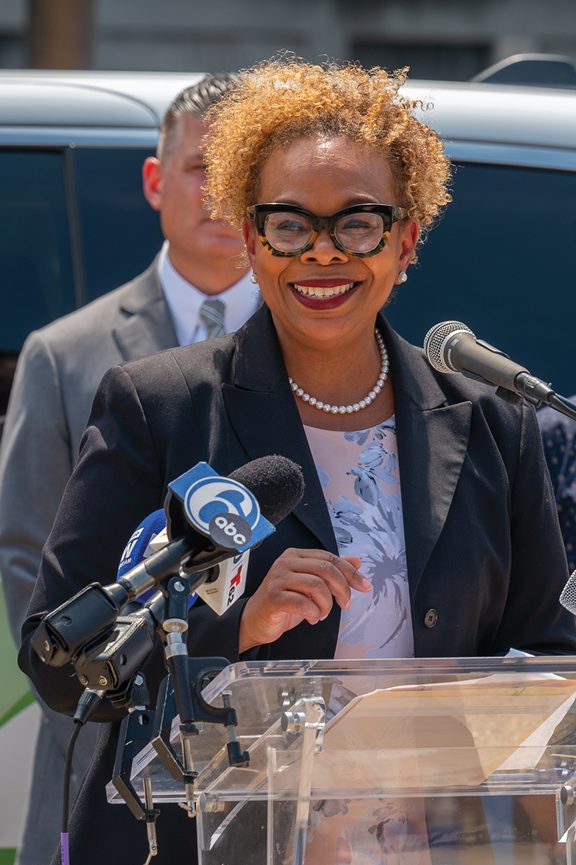 “In the design of this program, we aimed to keep the Loop within the boundaries of Camden with the exception of one stop,” says Redd. “Camden is a food desert, which means there is no easy access to healthy, fresh food for many of our residents. So we included the New Jersey Transit Stop in Cherry Hill, which is right next to a full-service grocery store where we know many of our residents shop.”
“In the design of this program, we aimed to keep the Loop within the boundaries of Camden with the exception of one stop,” says Redd. “Camden is a food desert, which means there is no easy access to healthy, fresh food for many of our residents. So we included the New Jersey Transit Stop in Cherry Hill, which is right next to a full-service grocery store where we know many of our residents shop.”
Camden is one of the latest cities in the country to adapt this program in partnership with Via, a software and operations company that delivers flexible public transit systems in forward-thinking cities across the country. Camden’s program is modeled after successes in places like Jersey City and Birmingham, Alabama.
“We certainly recognize that there’s more work to do, especially as we continue to adjust to a post-pandemic hybrid work model,” says Camden City Council President Angel Fuentes.“But it’s also given us an opportunity to think deeply about how we can support our residents to succeed in this new, global economy from the very beginning of the trend – not from a place of catching up with the rest of the country.”
“The Camden Loop creates an affordable and efficient transportation option to get residents to other modes of public transportation that connect them to parts of the city.”
-President and CEO of Camden Community Partnership Dana Redd
“The Camden Loop creates an affordable and efficient transportation option to get residents to other modes of public transportation that connect them to parts of the city.” As part of a broader vision, Camden’s approach involves not only enhancing transportation but also integrating it into a larger framework of urban renewal and community development by connecting residents to essential services and fostering interactions within the community.
“This has been a game changer,” says Candace Knight, a regular Camden Loop rider since its initial launch. “So many of us needed this, but we didn’t realize how much we needed it until we saw just how much easier it made our commutes and how many more opportunities it opened for us.”
Knight works along the Camden Waterfront. She doesn’t drive, and her commute could take anywhere from 20 to 30 minutes from her home, depending on the bus schedule. Even the best-run public transit systems in the world don’t run like clockwork all the time, which meant that Knight always had to leave a little room for delays – or risk being late.
“Now I get there in 10 minutes, and I know for sure that I will be on time every day,” she says.
“If you want to make an impact, you have to get creative. You have to think outside of the box.” -Camden City Mayor Victor Carstarphen
The Camden Loop stands as a testament to the city’s larger efforts to reshape its narrative and improve residents’ lives. It’s a holistic system that supports our residents in overcoming the barriers and inequities they have faced for decades, says Redd.
“Camden has really turned a corner,” she adds. “We used to be known as the most dangerous and impoverished city in America. Our schools were performing at one of the lowest levels in the State of New Jersey. Other cities might not be too keen to own up to statistics like that, but it’s a part of our history. It’s a part of where we come from, and it shows us how far we’ve come.”
City leaders, rather than diminishing the harsh realities of past statistics, have embraced them to forge a path forward. This forward-thinking strategy is shared with community organizations, private companies, nonprofits and residents to address not just the symptoms but the root causes of the city’s challenges.
“If you want to make an impact, you have to get creative,” says Camden City Mayor Victor Carstarphen. “You have to think outside of the box.”
What distinguishes the Camden Loop from typical national ride-sharing services isn’t just the competitive pricing but its foundational commitment to fostering local connections. This innovative program employs Camden County residents to drive their fellow neighbors within city limits.
“A friend of mine is a Loop driver, and he loves it because he gets to help the community from inside the community,” Carstarphen says. “We’re all working together, and it adds a sense of pride. He gets to help Miss Sally get to her doctor’s appointment, or make sure Mr. John gets to work on time.”
This is the type of connection that forms true community through conversation, accountability and trust, the Mayor says.
“These are people from the community moving through the community,” explains Carstarphen. “It’s allowed so many residents to get to know each other and connect to each other in a way they couldn’t before. You get to have these conversations that normally wouldn’t pop up, and you get to know more about your neighbors, their lives, their families, their interests.”
That’s been Ferguson’s experience as well.
“We’re kind of like bartenders and hairdressers,” she says. “People come in and they talk to us about their lives.”
Prior to joining the Camden Loop program, she drove for Uber and Lyft. Not only is the pay more consistent ($22/hour), she says, but she feels in touch with other residents in the city in a way she never has before.
“There are people I see often, and I’ve gotten attached to a lot of customers,” Ferguson says. “There’s Miss Sonia – she’s a school teacher. She’s so sweet and easy to talk to. There’s Camilla, who works as an aide and chats with me on the way to the grocery store to pick up materials for things she’s making for the kids. These are small details, but those are the ones that make you feel the most connected.”
It’s not uncommon to bump into regulars after-hours as well, she says.
“Sometimes they do a double take and say hey, you’re the Loop Lady! It’s always a really pleasant surprise,” says Ferguson.
Right now, the city is tracking the data to see how they can adjust any details or routes to best meet riders’ and drivers’ needs.
“We’re very proud of the progress we’ve achieved to date and are looking forward to expanding the service based on comments and feedback we’ve been getting throughout its first year,” says Redd.
A current solution in the works is the introduction of a prepaid rider card, which also aims to inclusively expand the service’s reach, especially benefiting those without traditional banking means. This broadened access to employment opportunities and increased social connection serves a part of Camden’s larger mission to retain talent within the city.
“While we work to fix social issues we face within the city, we are always asking ourselves, ‘What can we do to keep residents in the City of Camden? How do we retain skilled workers to provide services within city limits, and how do we entice young people at our schools to stay here and use their education to better our communities,” says Carstarphen. “The key, we’ve found, is to increase opportunities and make them feel like they are part of a community, working toward a bigger mission.
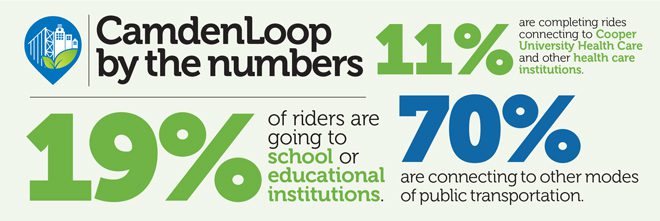
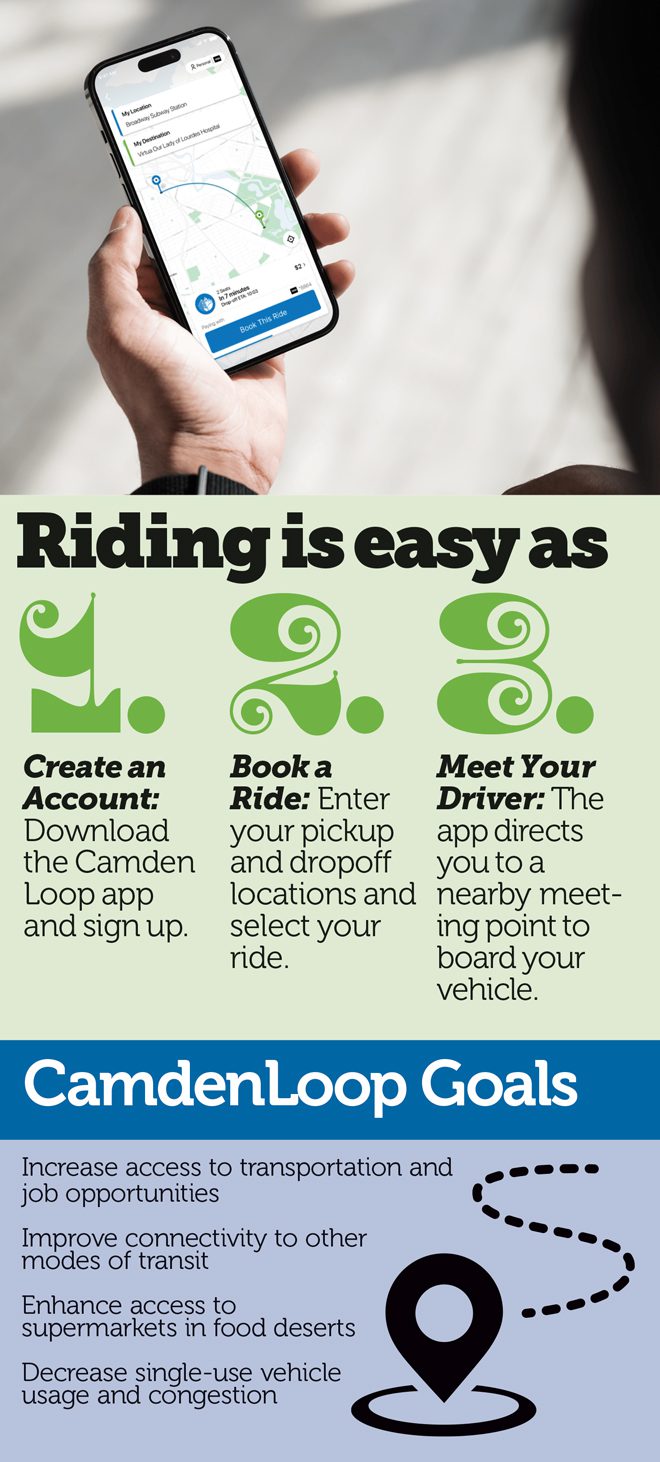
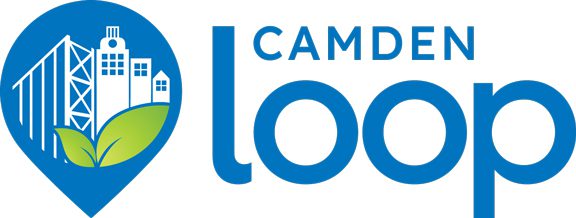

 “The Camden Loop creates an affordable and efficient transportation option to get residents to other modes of public transportation that connect them to parts of the city.”
“The Camden Loop creates an affordable and efficient transportation option to get residents to other modes of public transportation that connect them to parts of the city.”